Paper Mario
Released: August 11, 2000
Paper Mario (Mario Story) is a role-playing video game developed by Intelligent Systems and published by Nintendo for the Nintendo 64 . It was first released in Japan on August 11 , 2000 , in North America on February 5 , 2001 , and in Europe on October 5 , 2001 .
Paper Mario was a spiritual sequel to Super Mario RPG: Legend of the Seven Stars for the Super NES , and is the first game in the Paper Mario series of video games.
The game's English title comes from its unique graphical style, reminiscent of older Mario titles, which features 2-D looking characters resembling paper cutouts contained within 3-D environments, with a full range of 3-D movement.
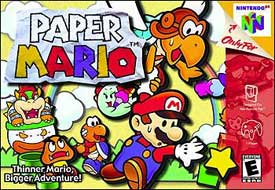
The story of Paper Mario begins with an introduction to Star Haven, a place where the seven Star Spirits reside and, using the Star Rod, an item with the power to grant any wish, grant the requests of those who wish upon the stars. The story's conflict begins when King Bowser and his assistant Kammy Koopa invade Star Haven, steal the Star Rod and transform the seven Star Spirits into playing cards.
Meanwhile, Mario and Luigi , unaware of what has taken place, receive an invitation from Princess Peach to a party at her castle. Upon arrival, Mario retires from the guests to the back of the castle to pay a visit to Peach in private. Peach greets Mario and asks him to accompany her to her balcony. Before Mario and Princess Peach reach the balcony, a loud rumbling noise is heard. The Princess's castle is then lifted into the sky by a fortress that had been located underneath the ground below the castle. Bowser then enters the castle and reveals that he is once again attempting to kidnap Princess Peach. Mario does battle with Bowser, but fails because of the Star Rod's ability to make Bowser invincible. After defeating Mario, Bowser casts him out of the castle to the Mushroom Kingdom below.
Mario lands injured and unconscious in a grassy clearing. Projections of the seven Star Spirits appear above Mario and with the strength that remains within them, the Star Spirits give the wounded Mario the strength to survive via these projections. Soon after, a Goomba girl encounters Mario still unconscious and takes him to her village to heal. During his unconscious state in the village, Mario receives a vision from Eldstar, one of the Star Spirits, telling him to come to Shooting Star Summit as soon as possible, as the Star Spirits will be better able to communicate with him there. After arriving at Shooting Star Summit, the seven Star Spirits reveal to Mario what Bowser has done and tell him that the only way he will be able to defeat Bowser is to rescue all seven of them, each of whom has been placed under the care of Bowser's minions in a particular area of the Mushroom Kingdom, for only their combined power will be able to overcome that of the Star Rod.
Throughout his quest, Mario makes many friends and succeeds in rescuing the seven Star Spirits, who then open up a portal atop Shooting Star Summit providing access to Star Haven. Upon arriving there, the Star Spirits combine their power and grant Mario an ability called the Star Beam, which can negate the effects of the Star Rod, and also provide Mario with a flying machine for him to use to gain access to Bowser's flying fortress. Mario enters the fortress and confronts Bowser again, revealing to Bowser that he is now able to counter the Star Rod. Bowser, however, lures Mario to an area where a machine is kept that he uses to amplify his power to such an extent that he becomes resistant to the Star Beam. Princess Peach upon seeing this makes a desperate wish upon the stars in Mario's favor. As the Star Spirits gain their power from people's wishes, this wish provides them with enough power to increase that of the Star Beam, now called the Peach Beam (with a little help from Twink), allowing Mario to defeat Bowser and recover the Princess and the Star Rod. Bowser's castle and his device that was used to increase his power is destroyed causing him and Kammy Koopa to fall off the castle. The Star Spirits carefully put Peach's castle back in its original place. Twink says a tearful goodbye to Princess Peach before leaving to Star Haven.
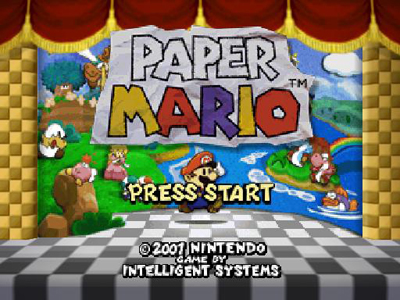
Back at home, Mario has finished telling Luigi the story, when Parakarry arrives with a letter to Peach's castle. All of the party members that had joined Mario on his quest are also invited as the guests of honor. Upon entering the castle, Peach emerges, congratulating Mario and his friends for retrieving the Star Rod and defeating Bowser.
After a humorous parade through the credits (led by Luigi, of course), Mario takes Peach to his house to watch the fireworks, with the intro music playing lullaby-style.
Gameplay
A distinguishing characteristic of Paper Mario is that, while the game features a 3D environment similar to that used in Super Mario 64 , the characters are designed as flat two-dimensional sprites reminiscent of 16-bit Mario titles, creating the impression of the characters being paper figurines.
Another departure from previous Mario games and from RPGs in general is the game's narration. The story is divided into eight chapters and a prologue. The beginning of a new chapter is announced with a cutscene and a scene with a curtain opening, similar to in a theatrical production. When the chapter is completed, another cutscene is shown with the curtain closing. In between these chapters, interludes showing dialogue between other characters take place, advancing the story. These interludes are also times when the player takes control of Princess Peach and attempts to navigate the castle while avoiding being seen by Bowser's guards.
Overworld
The action of Paper Mario is divided into two separate areas: the overworld and battle. The overworld is the area of the game in which the player navigates the game's locations, talks with characters, purchases items, and advances the plot. While in the overworld, Mario retains several basic actions including walking, running, and jumping. Other abilities include spinning, which speeds Mario's movement in conjunction with movement, hammering, which allows Mario to break certain
obstacles that hinder progress, and the spin jump, which allows Mario to break through certain sections of floor. Many parts of the overworld require the player to solve puzzles, complete tasks for certain characters, or navigate platform-style areas in order to progress through the game.
Battles are accessed by making contact with enemies that are visible in the overworld. Each individual enemy in the overworld may actually represent several enemies to fight in the upcoming battle. If the player attacks an enemy in the overworld by jumping or hammering, or using a party member's special ability, the battle begins with the player launching a preemptive strike. However, some enemies also have the ability to launch a first strike themselves, causing the battle to begin with the enemy attacking. Some "common-sense" axioms apply in battles, such as that ground-based attacks such as Mario's hammer attack cannot hit flying foes and that jumping on spiked enemies results in damage.
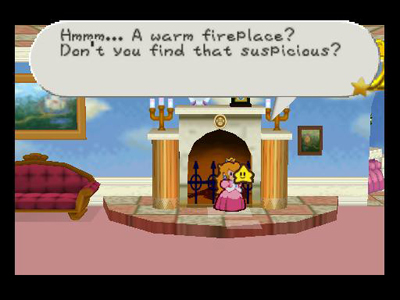
Battle
The other area of the game in which action takes place is in battle against enemies. Much like in Super Mario RPG , the battles in Paper Mario rely on a cross between traditional turn-based RPG battle system and timed button presses or other such motions that allow for increased damage to enemies or reduced damage taken, a concept known in the game as the Action Command . Paper Mario builds on this concept, introducing a larger variety of moves and timed actions. Unlike in Super Mario RPG , the size of a party in battle is two, instead of three, with Mario and only one of his party members fighting against the enemies. Partners, however, can be exchanged during battle, an action which costs the turn of the character who performs the "switch partner" move unless Mario is equipped with certain badges. Mario's party members do not receive damage in the way that Mario does and enemies will not ordinarily attack them. While certain attacks are capable of hitting them, these attacks immobilize them for a few turns rather than doing damage in terms of Heart Points. If Mario runs out of Heart Points, the game is lost unless the player is in possession of certain items which bring Mario back to life after defeat in battle. If a player loses during battle, the game resumed from the last save point.
Heart Points (HP) Measure the amount of damage that Mario and his enemies can sustain before being defeated. When Mario attacks an enemy, the enemy loses a number of Heart Points equal to the attack power of the attack minus the enemy's defense; the same scenario is the case when Mario is attacked by an enemy. For instance, using Mario's basic hammer against an enemy with 0 defense will do 1 damage or 2 if the Action Command is successfully executed. If the enemy has 1 defense, then the aforementioned attack will do 0 damage or 1 damage, respectively. Flower Points (FP) Introduced in Super Mario RPG , Flower Points are a resource shared between Mario and his party members used for executing special techniques (these include moves that Mario acquires by wearing badges and abilities that his party members gain after ranking up). Unlike Super Mario RPG , though, enemies do not use Flower Points. Badges Badges replace the traditional RPG staples of armor and other accessories. Badges provide a wide range of effects, such as bestowing new combat abilities, allowing Mario to jump on enemies that would normally damage him, or increasing Mario's attack or defense power. Different badges are effective in different situations. Badge Points (BP) are a method of limiting the number of badges that Mario can equip. Each badge requires a certain number of Badge Points to equip, which forces the player to use strategy in equipping different combinations of badges in different situations. Leveling up Similar to the leveling system in Super Mario RPG , gaining a level allows the player to choose between raising Heart Points, Flower Points, or Badge Points. Unlike in Super Mario RPG , in Paper Mario , the player-selected bonus is the only statistical upgrade a character receives for leveling up and is the only way to raise ability stats aside from equipping certain badges. Mario's maximum level is 27. While Mario's attack and defense cannot be increased by leveling up, they can be increased by equipping certain badges or, in the case of attack power, acquiring new gear. Leveling up is accomplished by gaining Star Points, which Mario earns when the player win a battle, the number per battle earned being based on the number and strength of the enemies defeated. When the Star Point meter reaches 100, Mario can level up. For every level gained, the number of Star Points that each type of enemy is worth decreases; eventually some enemies become worth no Star Points. While Mario's party members do not gain levels in the way that Mario does, they can be increased in what is known as rank by finding Super Blocks. When Mario hits a Super Block, the player may choose which of the party members to increase in rank. Increasing a party member's rank increases the attack power of that party member and gives it a new ability to use in battle. Each party member can be increased in rank twice. Gear At certain points in the game, Mario will acquire a new hammer or boots. These items increase the attack power of his hammer and jump attacks in battle, respectively, and also provide him with new abilities for use in the overworld; more specifically, acquiring a new hammer will allow Mario to break blocks with his hammer attack that he couldn't before, while acquiring a new pair of boots will allow him to perform a ground-pound style move which can break through sections of floor or allow him to levitate and hit objects above him that are too high to hit with a normal jump. Star Spirit powers Star Spirit powers are special combat abilities that are acquired by rescuing the Star Spirits. Each Star Spirit grants Mario a unique power and increases his Star Power meter by one unit. Star Power is a special resource which is used to perform Star Spirit powers. Each power requires a certain number of units of Star Power to use. During battle, expended Star Power will recover gradually each turn; the rate of this process can be increased by performing a Focus ability at the expense of a turn. While in the overworld, Star Power can only be recovered by resting at an inn.
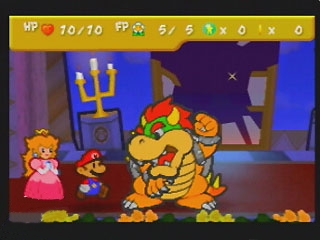
Main characters
The main protagonist of the game. After Bowser steals the Star Rod, imprisons the seven Star Spirits, and captures Princess Peach, he is forced to journey across the Mushroom Kingdom in search of the Star Spirits, as only by rescuing them will he be able to match the power of the Star Rod. He eventually succeeds in rescuing the Star Spirits, and afterwards defeats Bowser and recovers the Star Rod and the Princess. Princess Peach The Princess of the Mushroom Kingdom. She is captured along with her castle by Bowser. During her imprisonment, she along with the help of Twink assists Mario by secretly gathering information as to the whereabouts of the Star Spirits and having Twink relay the information to Mario. During Mario's final confrontation with Bowser, she makes a wish upon the stars which provides the Star Spirits with the energy to give Mario the power to defeat Bowser. Bowser Mario's archnemesis and the game's main antagonist. He and his assistant Kammy Koopa steal the Star Rod and imprison the seven Star Spirits. Afterwards, he captures Princess Peach along with her castle and with the power of the Star Rod initially defeats Mario in battle, but in the end is defeated by Mario and forced to return the Star Rod and the Princess. Kammy Koopa A female Magikoopa and Bowser's chief assistant. Kammy assists Bowser when he steals the Star Rod and imprisons the Star Spirits, and attempts on certain occasions to hinder Mario's progress. At the beginning of Mario's final battle with Bowser, she increases Bowser's power with a machine she has constructed to such an extent that the power of the Star Spirits have no affect on him, though in the end the two are defeated nevertheless. Twink A young star kid. Shortly after her capture by Bowser, Princess Peach makes a wish that someone would help her. Hearing this wish, Twink arrives to offer her/his aid. Throughout the game, Twink acts as a messenger for Peach, delivering the information that Peach secretly gathers about the Star Spirits to Mario.Party members
As Mario progresses through his adventure, he encounters the following characters, all of whom join him in his quest to recover the Star Spirits and defeat Bowser:
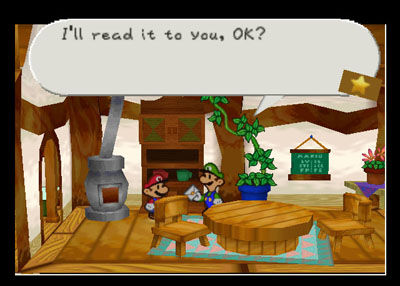
Goompa While not necessarily a partner per sé, he does join Mario at the beginning of the game and gives him advice on the battle system, etc. He is not playable, however, and does not participate in battles. Once a certain objective is complete in the first area of the game, however, he no longer needs to accompany you and retires just before you get your first real party member. Goombario A brash young Goomba who aspires to become an adventurer like Mario. His special ability gives information about Mario's current location on the map or about nearby objects or people. During battle, he can use his Tattle ability to give information about a particular enemy and cause that type of enemy's heart points to be revealed in all future battles. Goombario attacks in the form of jumping and landing on an enemy with his head, which is similar to Mario's Jump attack. His name is an obvious amalgam of Goomba and Mario (at one point in the game his own mother says he was named after Mario). In Japan he is known as "Kurio", an amalgam of "Kuribo" (as "Goomba" is called in Japan), and Mario. Kooper A Koopa Troopa with a distinctive blue shell who admires a certain Professor Kolorado and desires to become an archeologist like him. His special ability allows Mario to launch his shell forward, which can allow him to reach objects that are out of reach and can also be used as a first strike against enemies. In battle, Kooper attacks with his shell, which prevents him from taking damage from attacking hazardous enemies (e.g. enemies that are covered in flames) but cannot hit flying enemies. His name is actually a reference to the a/ar/er ambiguity found in Japanese. In Japan he is known as "Kameki". Bombette A hot-tempered pink Bob-omb whom Mario rescues from the Koopa Bros. fortress. Her special ability causes her to explode, which is capable of destroying certain obstacles and being used as a first strike. During battle, she can attack with explosions, which are capable of flipping shelled enemies and reducing their defense. She is called "Pinky" in Japan. Parakarry A Paratroopa who is a postman for the Toad Town post office. His special ability allows him to carry Mario a short distance, which can be used to cross gaps too wide to jump. As Parakarry flies, he is capable of attacking enemies no matter where on the battlefield they are. At certain points during the game, the player may find stray letters, which Parakarry is capable of delivering to their intended recipient, which usually results in a reward for Mario. In Japan he is known as "Paretta". Bow A green Boo with a pink bow and fan who is the lady of a certain Boo Manor (hence "Lady Bow"). Her special ability causes Mario to turn invisible while not moving, which prevents him from being spotted by enemies. During battle, she can hide Mario for a turn, which causes enemy attacks to miss, and is capable of attacking enemies no matter where they are on the battlefield. She is called "Resaresa" in Japan (after "Teresa" which is what the character "Boo" is called in Japan) Bow makes a cameo in Paper Mario's sequel, Paper Mario The Thousand Year Door. She is accompanied by her butler, Bootler, and appears, once you defeat the Shadow Queen, in Poshley Heights. Watt A Li'l Sparkey whom Mario recovers from a lantern wielded by a ghost. Her special ability allows her to illuminate his surroundings, which causes dark areas to become visible and can reveal hidden blocks. Watt's basic attack (in fact, her only attack) zaps an enemy with electricity, which penetrates defenses. She can also attack enemies regardless of their location on the battlefield. In Japan, she is known as "Pikarin". Sushie A Cheep Cheep who acts as a babysitter for the Yoshis of Lavalava Island. Her special ability allows Mario to ride her across bodies of water. During battle, she can attack enemies by spraying them with water, which is especially effective against fiery enemies. Her name is an obvious reference to sushi . In fact, as revealed in one of her letters, she has a daughter named "Sashimie" (which refers to sashimi another Japanese form of raw fish). In Japan, she is known as "O-Puku". Lakilester A Lakitu who wears sunglasses and prefers to be called "Spike". His special ability allows him to carry Mario in his cloud, which allows Mario to pass over hazardous terrain and improves his overall movement speed as well. During battle, Lakilester attacks by throwing Spiny eggs at enemies, which allows him to attack hazardous enemies without reprisal and can hit enemies no matter where their location on the battlefield. In the Japanese version, he is called "Pokopi" and prefers to be called "Johnathan".
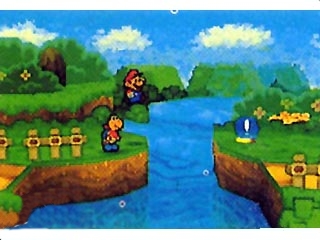
Locations
Paper Mario takes place in a "real world" environment, with many towns, castles, and areas of wilderness which can be identified as geographical locations. The game is set in the Mushroom Kingdom , which is divided into different regions through which Mario must traverse. Locations include a tropical island, a vast desert, a frozen mountain, a haunted forest, a paradise flower garden, and the inside of a toy box.

